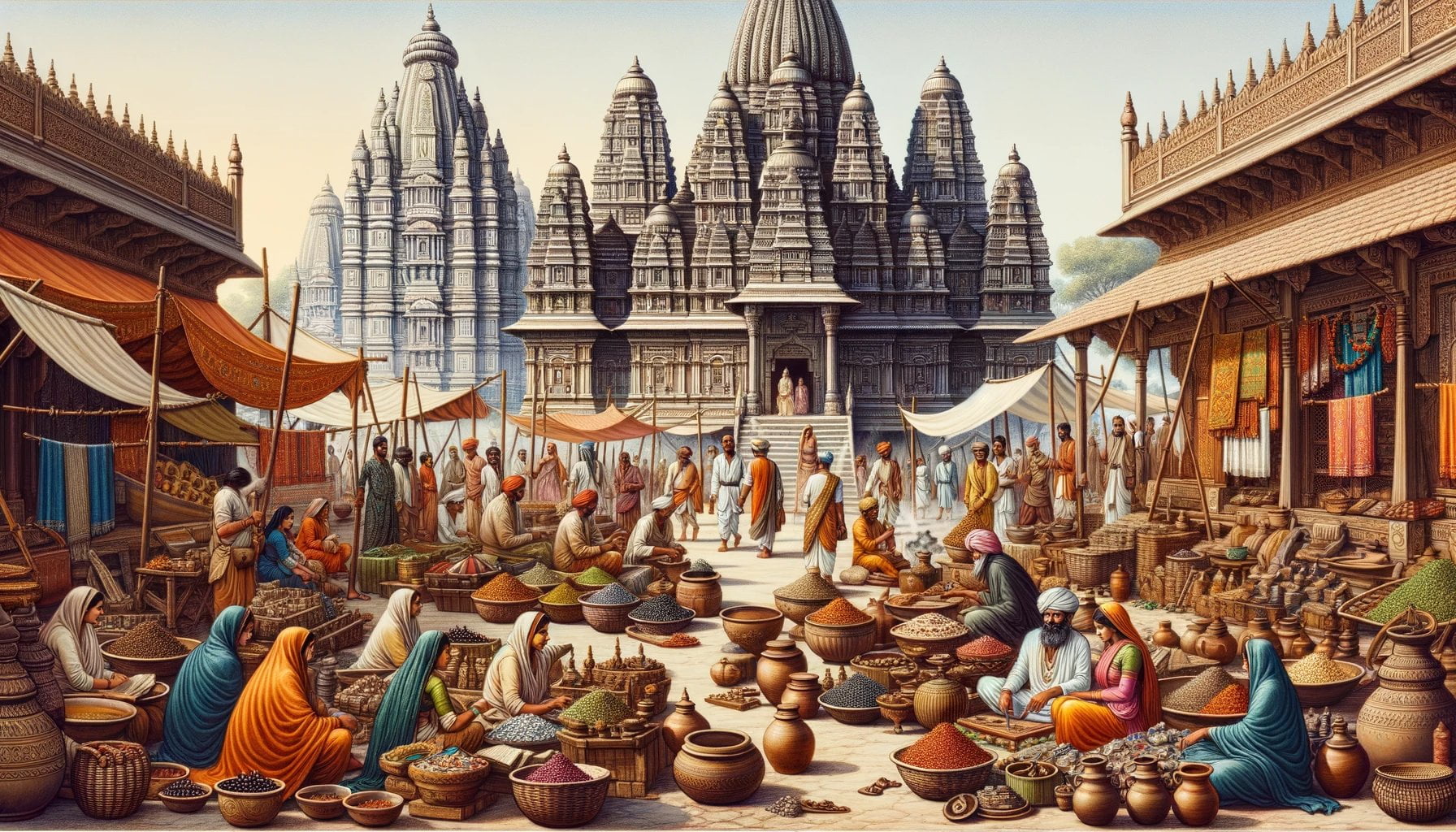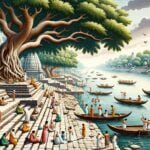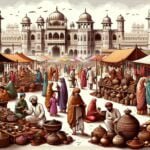Unveiling Ancient India’s Economic System: Economics in Ancient India Explored. Journey back in time to the vast and mysterious land of ancient India, where a fascinating and sophisticated economic system thrived. In this captivating exploration, we delve into the intricate workings of ancient Indian trade, the enigmatic social structures that shaped economic practices, and the profound economic thought that guided this ancient civilization. Join us on this illuminating journey as we unearth the secrets of ancient India’s economic prosperity and shed light on its economic legacy that continues to influence the world to this day.
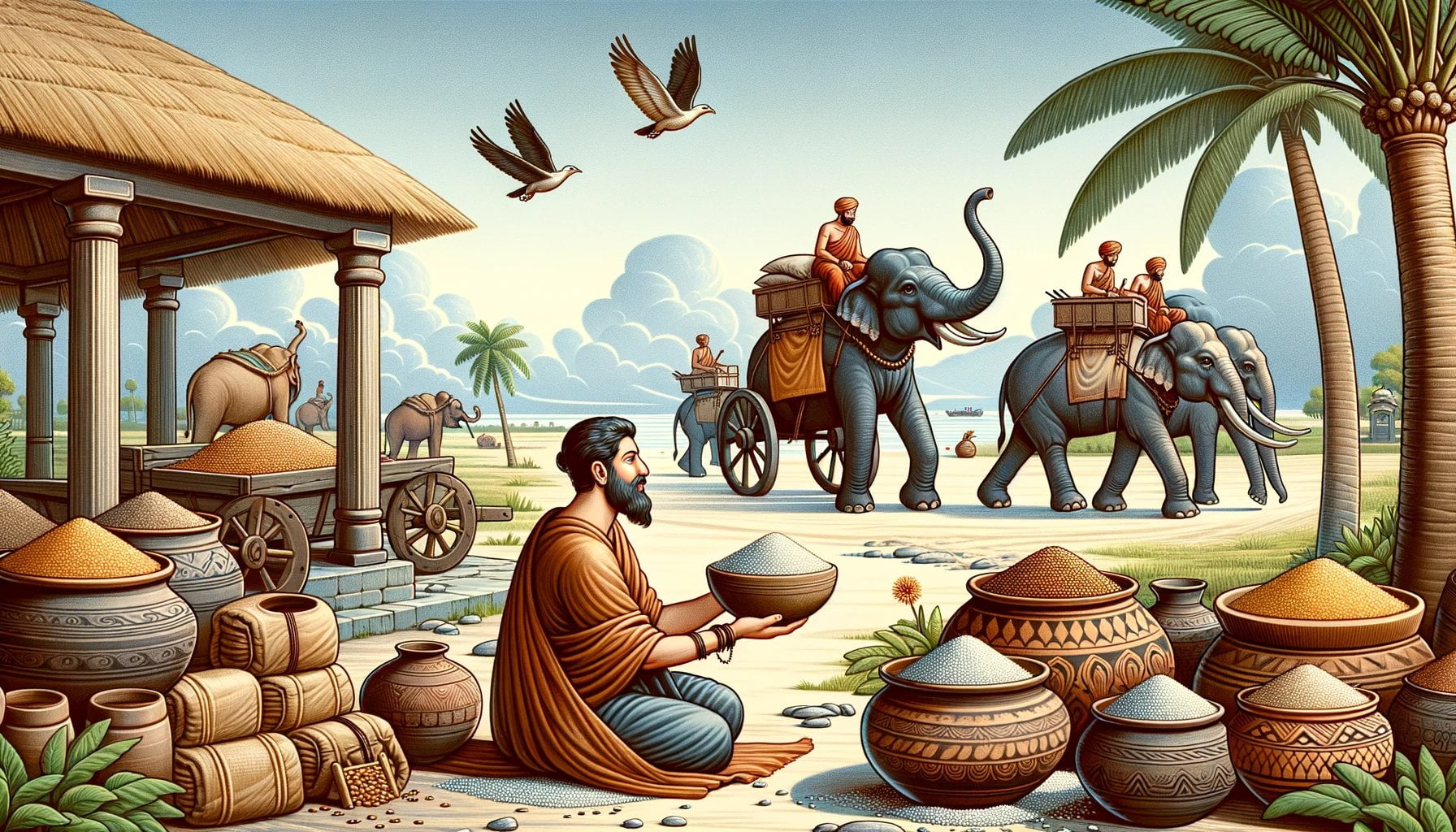
Key Takeaways:
- The economy in ancient India heavily relied on agriculture, with it being the primary occupation.
- Ancient India had a predominantly rural and agrarian-based economy.
- Ancient India was one of the largest economies globally for over 2,500 years, from the end of the 1st millennium BC until the beginning of British rule.
- During this period, punch-marked silver coins were minted, and there was an active trade network and urban development.
- Exploring the main crops of ancient India can provide insights into their agricultural practices.
- Understanding the impact of trade on the ancient Indian economy is crucial for comprehending their economic system.
- Investigating the challenges faced by the ancient Indian economy can reveal the obstacles they had to overcome.
- Analyzing how British rule influenced India’s economy can shed light on significant changes that occurred during that time.
Economics in Ancient India
The economy of ancient India was a fascinating and intricate system that revolved around agriculture. Agriculture was the backbone of the economy, with the majority of the population engaged in farming as their principal occupation.
In ancient India, the economy was predominantly rural and agrarian in nature. The land was cultivated to produce crops, which formed the basis of sustenance and trade. Key crops grown during this period included rice, wheat, barley, millet, lentils, sugarcane, and cotton. These crops not only provided sustenance for the population but also served as important commodities for trading.
Trade played a significant role in shaping the economy of ancient India. Intensive trade activities and urban development were witnessed during this period. Trade routes linked the various regions, facilitating the exchange of goods and ideas. How did trade affect the economy in ancient India? Trade brought prosperity and wealth, as traders engaged in long-distance commerce, exporting goods such as spices, textiles, and precious metals. The trade routes extended to Southeast Asia, the Middle East, and even the Mediterranean. These trade connections not only brought in valuable resources but also enriched the cultural and intellectual landscape.
However, the ancient Indian economy also faced its fair share of challenges. What were the challenges faced by the ancient Indian economy? Natural calamities, such as floods and droughts, could devastate agricultural production, leading to food shortages and economic downturns. Additionally, the economy had to grapple with issues like lack of infrastructure, imperfect market information, and social inequalities, which posed hurdles to its growth and development.
It is crucial to understand that the economic history of ancient India extends beyond a particular time frame. India was one of the largest economies in the world for about two and a half millennia, from the end of the 1st millennium BC until the beginning of British rule. During this period, the economic system witnessed various changes and developments. For instance, the introduction of punch-marked silver coins during the Mauryan period facilitated trade and commerce. These coins were widely accepted as currency and played a crucial role in economic transactions.
However, with the advent of British rule, the Indian economy faced a significant transformation. How did British rule change the economy of India? The British implemented various policies that aimed at exploiting Indian resources and redirecting the economy to serve their colonial interests. This led to a decline in indigenous industries, loss of traditional knowledge, and a shift towards an export-oriented economy. The consequences of these policies were felt long after India gained independence, and it took considerable effort to revive and rebuild a self-sustaining Indian economy.
In conclusion, exploring the economics of ancient India takes us on a captivating journey into the past. The agricultural foundation, the thriving trade networks, the challenges faced, and the impact of foreign rule all contribute to a comprehensive understanding of Economics in Ancient India. It is through studying and unraveling this economic system that we can appreciate the rich heritage and historical significance of ancient India, as well as draw valuable insights for the present and the future.
The history of Government Ancient India is filled with intriguing tales of power, governance, and influence. Discover the fascinating political landscape of Ancient India by exploring the achievements, warriors, and politics that shaped its rich history. Click here to delve into the era of Government Ancient India: Government Ancient India
Unleash your curiosity and immerse yourself in the valor and legacy of the Ancient Warriors of India. Embark on a thrilling journey through time as you explore their remarkable feats and bravery. Intrigued? Click here to uncover the legends of the Ancient Warriors of India: Ancient Warriors of India
Experience the extraordinary accomplishments of Ancient India that continue to inspire awe even today. Discover the advancements and contributions made by this ancient civilization in various fields. Ready to be amazed? Click here to explore Ancient India’s astonishing achievements: Ancient India Achievements
Uncover the intricate web of political intrigue that characterized Politics in Ancient India. From power struggles to diplomatic maneuverings, the political landscape of this ancient civilization is a fascinating tale waiting to be discovered. Interested? Click here to delve into the intriguing world of Politics Ancient India: Politics Ancient India
Coinage and Currency in Ancient India
The evolution of coinage in ancient India offers fascinating insights into the economic history of the region. Numismatics, the study of ancient Indian coinage, showcases the significant changes in the monetary system over time. From the prehistoric era to the punch-marked coins of the Janapadas, ancient Indian coinage reflects the economic practices, trade activities, and cultural aspects of different historical periods.
Prehistoric and Bronze Age
In the prehistoric and Bronze Age era of ancient India, there is limited evidence of currency or exchange through barter systems. However, the Indus Valley Civilization stands out with its trade activities, evidenced by the use of commodities like cowry shells and possibly metals such as silver found in Mohenjo Daro.
Coins in the Vedic Period
The use of coins in ancient India can be traced back to the Vedic period. Although references to gold ornaments and valuable metals like nishka are found in the Rigveda, it remains uncertain whether these can be understood as coins. Nevertheless, later Vedic texts mention various terms related to currency, including nishka, suvarna, and shatamana.
Coinage During Janapadas
The most definitive evidence of coin usage in ancient India dates from the 6th-5th century BCE, during the period of the Janapadas. Coins from this era were primarily made of silver and bore distinct punch marks.
The circulation of punch-marked coins marked a significant shift in the coinage system of ancient India. These coins were typically made of silver and had symbols and marks punched onto them. This standardized system of coinage facilitated trade and commerce within and beyond the Indian subcontinent.
Ancient Indian coinage holds immense historical importance as it provides valuable insights into the economic and cultural aspects of ancient India. The motifs, symbols, and stamps used on the coins reflect the rulers and their reign, making numismatics an essential field of study for historians and archaeologists.
Key Takeaways:
- Coinage played a crucial role in the economic history of ancient India, with the study of ancient Indian coinage, known as numismatics, revealing the evolutionary changes in the region’s monetary system.
- The Indus Valley Civilization conducted trade activities using commodities like cowry shells and possibly metals like silver.
- The Vedic period marked the beginnings of coin usage in ancient India, although the exact nature of these early “coins” remains uncertain.
- The Janapadas era saw definitive evidence of coin usage, with the circulation of punch-marked coins made primarily of silver.
- Ancient Indian coinage provides insights into the economic practices, trade activities, and cultural aspects of different historical periods.
Social Structure and Economic Inequality in Ancient India
Throughout history, social structure and economic inequality played a crucial role in shaping the dynamics of societies. In ancient India, these factors were no exception. As we delve into the economic history of ancient India, it becomes apparent that the social structure and economic inequality greatly influenced the economic systems prevalent during that time.
Context:
Ancient India was characterized by a diverse economic system, with the Maurya and Gupta dynasties playing significant roles in shaping trade, commerce, and economic thought. To truly understand the economic landscape, it is essential to examine the social structure and economic inequality of ancient India.
Studies influenced by the nationalist movement following the partition of Bengal in 1905 shed light on economic conditions in ancient India. But before going further, we must discuss and analyze the key points from reputable sources, such as the Journal of Institutional Economics, by Rooney and Murthy, and an SSRN paper by Jain.
Source 1: Rooney, J. & Murthy, V. (2021). Institutions, social order and wealth in ancient India. Journal of Institutional Economics.
Source 2: Jain, H. (2019). The Ancient Indian Economic Thought & the Concept of Welfare. SSRN.
Key Takeaways:
- Ancient India had both state and private institutions, working together to provide stability in an uncertain world. This highlights the importance of social structure in maintaining economic order.
- Orthodox economic theorizing often downplays the presence of market institutions in ancient societies. However, ancient India had a diverse economic system that incorporated both state-controlled and private sector elements.
- The study of economic conditions in ancient India was influenced by the nationalist movement following the partition of Bengal in 1905. This movement sought to explore and highlight India’s rich heritage, including its economic history.
- Economic analysis and principles were exercised in ancient India as early as the 3rd century BCE, demonstrating the depth of economic thought within ancient Indian society.
- The British influence in India was viewed unfavorably by many, as it was seen as a force that disrupted the moral and social foundations of Indian society. Understanding the impact of British colonial rule helps us comprehend the economic inequalities that plagued ancient India.
- Studying ancient economic and political theories has relevance in today’s context, as it provides insights into the development of economic systems, social structures, and patterns of inequality. This understanding can contribute to shaping present and future economic policies.
Now, let’s delve deeper into the connection between social structure and economic inequality in ancient India.
The Interplay Between Social Structure and Economic Inequality:
Ancient Indian society was divided into various social classes or varnas. These varnas were stratified in a hierarchical order, with the Brahmins (priestly class) at the top, followed by Kshatriyas (warriors and rulers), Vaishyas (merchants and farmers), and Shudras (laborers and servants). This social structure played a significant role in shaping economic inequality.
In ancient India, the social classes had distinct economic roles and rights. The Brahmins held knowledge and spiritual authority, while the Kshatriyas had political and military power. Vaishyas engaged in trade and agriculture, while Shudras provided labor. This division of labor led to unequal distribution of resources and wealth, perpetuating economic inequality.
State and Private Institutions: Balancing Stability and Inequality:
Ancient India had both state and private institutions that operated alongside each other. State institutions, such as the Maurya and Gupta dynasties, played a crucial role in maintaining stability and governance. These institutions implemented policies that aimed to regulate economic activities, redistribute wealth, and minimize inequality. However, it’s important to note that these efforts did not necessarily eliminate or overcome economic disparities entirely.
Private institutions, on the other hand, were driven by individual and collective pursuits of wealth and prosperity. Trade guilds and merchant communities played a significant role in economic activities, promoting trade and commerce. However, private institutions also contributed to economic inequality, as wealth accumulation was often concentrated in the hands of a few individuals or groups.
The Impact of Economic Inequality on Society:
Economic inequality in ancient India had far-reaching consequences. It affected access to resources, social mobility, and the overall well-being of individuals and communities. The concentration of wealth in the upper classes limited opportunities for upward mobility, perpetuating economic disparities across generations.
Economic inequality also influenced social structures and power dynamics. The upper classes held significant influence and control over resources, political decision-making, and religious practices. This created a hierarchical society, where opportunities for education, healthcare, and social advancement were disproportionately distributed.
Exploring Economic Inequality in Ancient Indian Texts:
Deciphering ancient texts and archaeological evidence provides insights into the economic practices and thoughts of ancient India. Brahmanical and Buddhist sources shed light on economic activities, the perception of wealth, and efforts to address economic inequality.
Ancient texts like the Arthashastra, authored by Chanakya (Kautilya), provide insights into economic policies and strategies to alleviate poverty and inequality. These texts indicate that ancient Indian societies recognized the impact of economic inequality and made efforts to minimize its negative consequences, although the outcomes varied.
Conclusion: Insights into Ancient India’s Economic System
Studying social structure and economic inequality in ancient India reveals that these factors played a crucial role in shaping the economic systems of that era. The hierarchical social structure, efforts by state and private institutions, and the impact of economic inequality provide valuable insights into the complexities of ancient Indian society.
By understanding the economic practices, trade routes, and social structures of ancient India, we gain a deeper appreciation for the economic history of this region. Examining this historical epoch helps us draw valuable insights that have relevance even in today’s context, informing economic policies and addressing social inequalities.
Sources:
- Rooney, J. & Murthy, V. (2021). Institutions, social order and wealth in ancient India. Journal of Institutional Economics, 17(1), 91-104.
- Jain, H. (2019). The Ancient Indian Economic Thought & the Concept of Welfare. SSRN. Link
Key Takeaways:
– Social structure and economic inequality were intertwined in ancient India, with the varnas shaping the distribution of resources and wealth.
– Both state and private institutions played a role in maintaining stability, regulating economic activities, and contributing to economic disparities.
– Economic inequality had profound consequences for social mobility, access to resources, and overall well-being in ancient Indian society.
– Ancient texts provide insight into economic policies and attempts to address economic inequality, highlighting the acknowledgement of its impact in ancient Indian society.
Economic thought and theories in ancient India
The study of economic thought and theories in ancient India sheds light on the culture, tradition, and national characteristics of the country. Ancient texts such as the Vedas, Arthasastra, Ramayana and Mahabharata, Manusmriti, and Sukraniti provide valuable insights into the economic ideas prevalent during that time period (source: UNIT-V INDIAN ECONOMIC THOUGHT – gacbe.ac.in). These texts not only offer economic policies laid down by Kautilya, but also showcase the pragmatic application of modern economic principles (source: UNIT-V INDIAN ECONOMIC THOUGHT – gacbe.ac.in).
It is important to note that there is a prevailing perception that ancient Indian literature on economic matters is fatalistic and combines sacred and secular thoughts. However, these texts provide a comprehensive perspective on Indian economic thought, leading up to and after the Arthashastra (source: Economic Sutra: Ancient Indian Antecedents to Modern Economic Thought – amazon.in). By studying these ancient texts, researchers can gain a deeper understanding of the economic concepts and policies prevalent in ancient India, and how they influenced the country’s culture, tradition, and national characteristics.
Key Takeaways:
– The Vedas, Arthasastra, Ramayana and Mahabharata, Manusmriti, and Sukraniti serve as major sources of information about economic ideas in ancient India (source: UNIT-V INDIAN ECONOMIC THOUGHT – gacbe.ac.in).
– Ancient Indian texts not only provide economic policies laid down by Kautilya but also showcase the pragmatic application of modern economic principles (source: UNIT-V INDIAN ECONOMIC THOUGHT – gacbe.ac.in).
– Ancient Indian literature on economic matters is often seen as fatalistic and a mix of sacred and secular thoughts (source: Economic Sutra: Ancient Indian Antecedents to Modern Economic Thought – amazon.in).
– Studying ancient Indian economic texts helps in understanding the economic concepts and policies prevalent in ancient India and their influence on the country’s culture, tradition, and national characteristics.
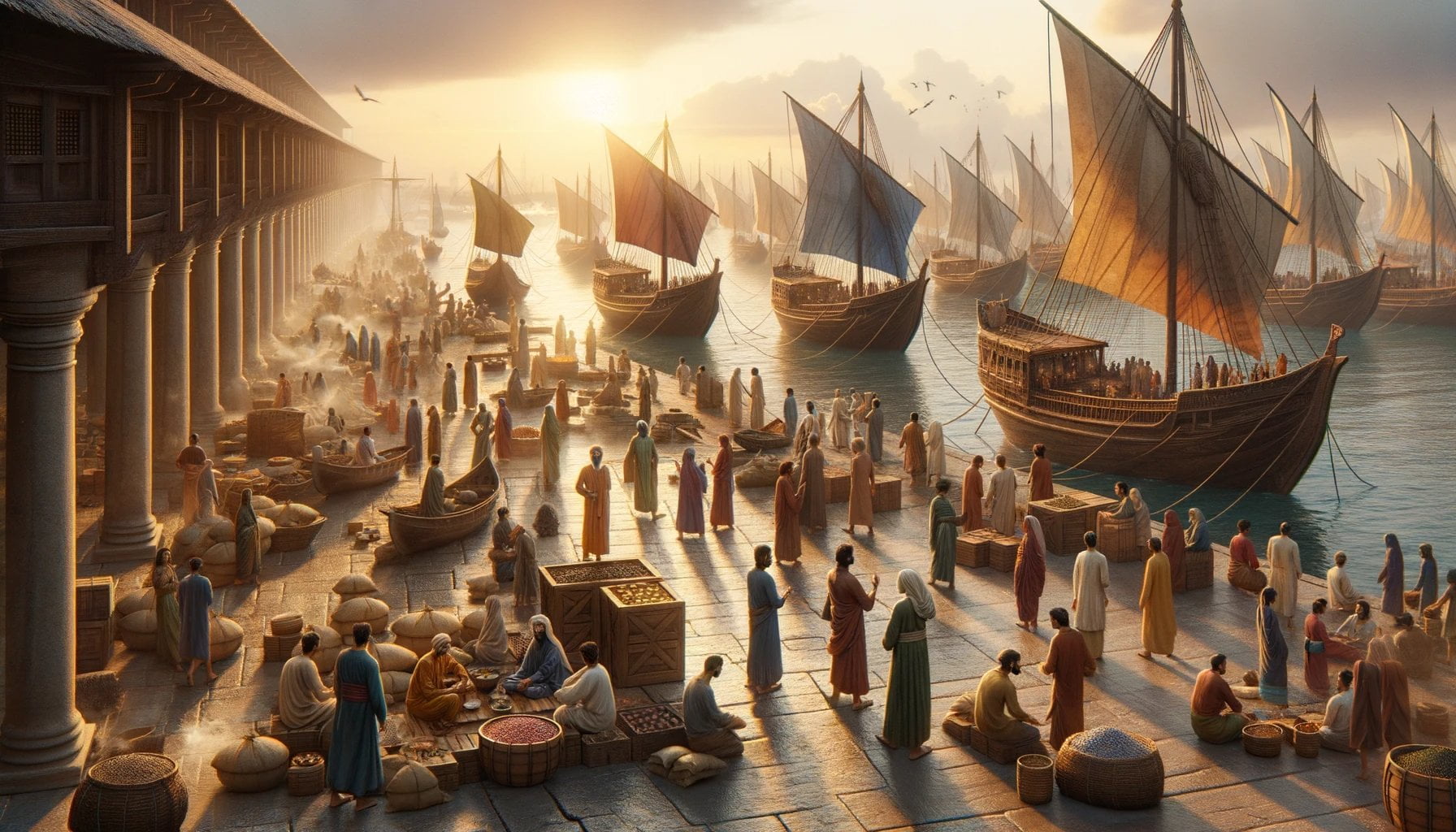
FAQ
Q1: What was the main occupation in ancient India’s economy?
A1: The main occupation in ancient India’s economy was agriculture.
Q2: How did trade impact the economy in ancient India?
A2: Trade had a significant impact on the economy in ancient India. It facilitated economic growth, cultural exchange, and the development of urban centers.
Q3: What were the main crops in ancient India?
A3: The main crops in ancient India included rice, wheat, barley, millet, and pulses.
Q4: What were the challenges faced by the ancient Indian economy?
A4: The ancient Indian economy faced challenges such as natural disasters, invasions, political instability, and social inequality.
Q5: How did British rule change the economy of India?
A5: British rule significantly impacted the economy of India. It led to the exploitation of resources, destruction of traditional industries, and the introduction of new economic policies that favored British interests.
“`json
“`
